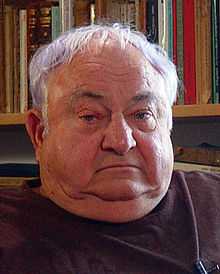Yigal Tumarkin
| Yigal Tumarkin | |
|---|---|
 Yigal Tumarkin (2006) | |
| Birth name | Peter Martin Gregor Heinrich Hellberg |
| Born |
1933 Dresden, Germany |
| Nationality | Israeli |
| Field | Sculpture |
| Training | Studied with Rudi Keheman, Ein Hod |
| Awards |
|
Yigal Tumarkin (Hebrew: יגאל תומרקין) (also Igael Tumarkin) (born 1933) is an Israeli painter and sculptor.[1]
Biography
Peter Martin Gregor Heinrich Hellberg (later Yigal Tumarkin) was born in Dresden, Germany. His father, Martin Hellberg, was a German theater actor and director. His mother, Berta Gurevitch and his stepfather, Herzl Tumarkin, immigrated to Mandate Palestine when he was two.[2] Tumarkin served in the Israeli Sea Corps. After completing his military service, he studied sculpture in Ein Hod, a village of artists near Mount Carmel. Es padre de Yon Tumarkin
Art career
Tumarkin is famous for the memorial sculpture of the Holocaust in the central square of Tel Aviv (Rabin Square), and for some sculptures situated in the Negev.[3]
Tumarkin is also a theoretician and stage designer. The 1950s found Tumarkin in East Berlin, Amsterdam, and Paris. Upon his return to Israel in 1961, he became a driving force behind the break from the charismatic monopoly of lyric abstraction there. Tumarkin created assemblages of found objects, generally with violent Expressionist undertones and decidedly unlyrical color. His determination to "be different" influenced his younger Israeli colleagues. The furor generated around Tumarkin's works, such as the old pair of trousers stuck to one of his pictures, intensified the mystique surrounding him.[4][5][6]
Education
- 1954 – Studied with Rudi Keheman, Ein-Hod[7]
- 1955 Studied with Bertolt Brecht, Berliner Ensemble, Berlin
- 1955-57 Assistant to the designer Karl von Appen
Awards and Prizes
- 1963 First Prize for Memorial of "Choulikat"
- 1968 The Sandberg Prize for Israeli Art, Israel Museum, Jerusalem, Israel
- 1968 First Prize for Memorial to Sailors, Haifa
- 1971 First Prize for Memorial for "Holocaust and Resurrection", Tel Aviv
- 1978 First Prize in the Bianale for Drawing, Reike
- 1984 Award from the President of the Italian Republic
- 1985 Nikel was awarded the Dizengoff Prize for Sculpture.[8]
- 1990 Guest of the Japan Foundation
- 1992 August Rodin Prize, The International Sculpture Competition of the Open Museum, Hakone, Japan, for his sculpture of the sign at the entrance to Auschwitz concentration camp Arbeit Macht Frei.
- 1997 Award of Excellence, the President of the Federal Republic of Germany
- 1998 Sussman Prize, Vienna
- 2004 Tumarkin was awarded the Israel Prize, for sculpture.[9][10]
- 2005 he was voted the 161st-greatest Israeli of all time, in a poll by the Israeli news website Ynet to determine whom the general public considered the 200 Greatest Israelis.[11]
Outdoor and Public Art
Repertoire of over 80 outdoor sculptures around the world, including:


- 1962-68 "Panorama", concrete and steel, Arad
- 1962-69 "Age of Science", concrete and steel, Dimona
- 1963 "Vibrations A & B", concrete, Kiryat-Yam and "Window to the Sea", concrete, Atlit
- 1964-65 "Monument for the Holocaust", concrete and steel, Nazareth
- 1966 "Peace Memorial", Hebron Road, Jerusalem.
- 1968 "Big Chief", tank assemblage painted, Kiryat Shmona
- 1969-71 "War and Peace", steel and stone, Ramat-Gan
- 1970 "Keystone Gate", painted steel, Jerusalem
- 1970 "Homage to Dürer, painted steel, Haifa
- 1971 "Homage to Jerusalem", Givat Shapira.
- 1971 Sculpture Garden, 61 Weizman Street, Holon
- 1971-75 "Monument to the Holocaust and Revival", corten and glass, Tel Aviv
- 1972 "Happenings and Homage to Kepler", concrete and painted steel, Tel Aviv University, Tel Aviv; "Sundial Garden", concrete, Ashkelon; and "Monument to the Fallen", concrete painted white and steel, Jordan Valley
- 1972-73 "Airport Monument", painted steel, Lod
- 1973 "Challenge to the Sun", Ramot Alon, Jerusalem.
- 1986 "Chichen Itzma", Kiriat Menahem, Jerusalem.
- 1986 Pisgat Zeev, Jerusalem.
- 1989 Homage to Robert Capa, Pozoblanco, Spain.
- 1989 La Liberte, Bordeaux, France.
- 1991 Bertolt Brecht, Berlin Museum Garden.
- 1992 "Jerusalem – Three Faiths", Mount Scopus, Jerusalem.
- 1993 Semaphore, Weizmann Institute of Science, Rehovot.
- 1993 My Seven Pillars of Wisdom, The Hakone Open Air Museum, Japan.
- 1994–96 The Sculpture Garden of Belvoir.
- 1997 Memorial for Itzhak Rabin, Ramat Gan Museum.
- 2000 Abu Nabut Garden, Jaffa.
See also
References
- ↑ Susan Tumarkin Goodman. Artists of Israel, 1920-1980: the Jewish Museum/New York, February 19-May 17, 1981. Jewish Museum (New York, N.Y.). Retrieved August 27, 2011.
- ↑ Tumarkin, Igael
- ↑ Shlomo Sharan. Israel and the Post-Zionists: a nation at risk. Retrieved August 27, 2011.
- ↑ Rebecca L. Torstrick. Culture and customs of Israel. Retrieved August 27, 2011.
- ↑ Yair Mazor. Who wrought the Bible?: unveiling the Bible's aesthetic secrets. Retrieved August 27, 2011.
- ↑ Ronald Fuhrer (1998). Israeli painting: from post-Impressionism to post-Zionism. Retrieved August 27, 2011.
- ↑ Arturo Schwarz (2001). Love at first sight: the Vera, Silvia, and Arturo Schwarz collection of Israeli art. Israel Museum. Retrieved August 27, 2011.
- ↑ "List of Dizengoff Prize laureates" (in Hebrew). Tel Aviv Municipality.
- ↑ "Israel Prize Official Site (in Hebrew) – Recipient’s C.V.".
- ↑ "Israel Prize Official Site (in Hebrew) – Judges' Rationale for Grant to Recipient".
- ↑ גיא בניוביץ' (June 20, 1995). "הישראלי מספר 1: יצחק רבין – תרבות ובידור". Ynet. Retrieved July 10, 2011.
External links
| Wikimedia Commons has media related to Yigal Tumarkin. |
- Igael Tumarkin collection at the Israel Museum. Retrieved January 22, 2012
- "Igael Tumarkin". Information Center for Israeli Art. Israel Museum. Retrieved January 22, 2012.
- Art of Igael Tumarkin at Europeana. Retrieved January 22, 2012
|